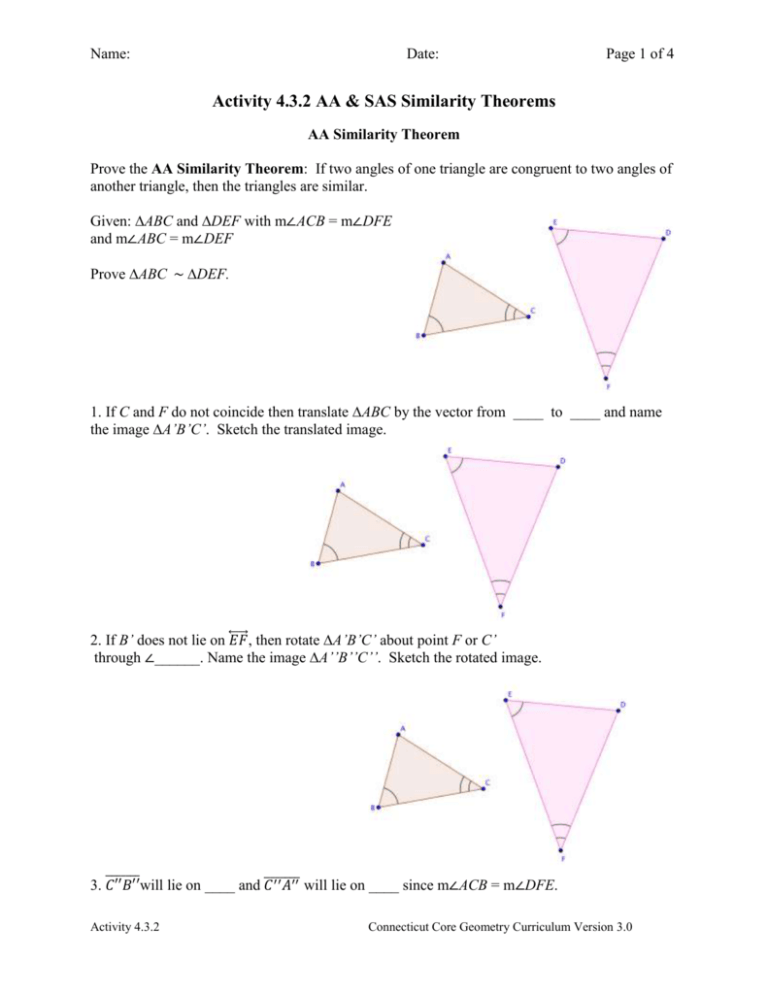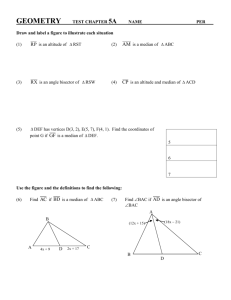Activity 4.3.2 AA & SAS Similarity Theorems
advertisement

Name: Date: Page 1 of 4 Activity 4.3.2 AA & SAS Similarity Theorems AA Similarity Theorem Prove the AA Similarity Theorem: If two angles of one triangle are congruent to two angles of another triangle, then the triangles are similar. Given: ∆ABC and ∆DEF with m∠ACB = m∠DFE and m∠ABC = m∠DEF Prove ∆ABC ~ ∆DEF. 1. If C and F do not coincide then translate ∆ABC by the vector from ____ to ____ and name the image ∆A’B’C’. Sketch the translated image. 2. If B’ does not lie on ⃡𝐸𝐹 , then rotate ∆A’B’C’ about point F or C’ through ∠______. Name the image ∆A’’B’’C’’. Sketch the rotated image. ̅̅̅̅̅̅̅will lie on ____ and ̅̅̅̅̅̅̅ 3. 𝐶′′𝐵′′ 𝐶 ′′ 𝐴′′ will lie on ____ since m∠ACB = m∠DFE. Activity 4.3.2 Connecticut Core Geometry Curriculum Version 3.0 Name: Date: Page 2 of 4 4. Since m∠A’’B’’C’’ = m∠_______ then _______ ||______ because when _____________ angles formed by two lines are a transversal are congruent, the two lines are parallel. 5. Dilate ∆A’’B’’C’’ using center point ______ by factor 𝐵"𝐶". Point B’’’ will then coincide with point ____. 6. By our dilation postulate: a. ⃡𝐵’’’𝐴’’’ || ⃡𝐵’′𝐴′’(Dilations map a line not through the center onto a parallel line.) Therefore, through point B’’’ (that is, point E) both ⃡𝐸𝐷 and ⃡𝐵’’’𝐴’’’ are parallel to ⃡𝐵’’𝐴’’. Since there is only one line through a given point parallel to a given line, this means that lines _____ and _____ coincide. b. ⃡𝐶’’𝐴’’will map onto ⃡𝐶’’′𝐴’’′ (Dilations map a line through the center onto itself). Since ⃡ two lines (𝐵’’’𝐴’’’ ) and ⃡𝐹𝐴’’’ intersect in at most one point. points _____ and ____ coincide. 7. Since ∆A’’’B’’’C’’’ coincides with ∆DEF, ∆DEF is the image of ∆ABC under a _______________ transformation. This means that ∆ABC and ∆DEF are _________________. This completes the proof. Activity 4.3.2 Connecticut Core Geometry Curriculum Version 3.0 Name: Date: Page 3 of 4 SAS Similarity Theorem Prove the SAS Similarity Theorem: If two sides of one triangle are proportional to two sides of another triangle and the angles included by these sides are congruent, then the triangles are similar. Given ∆ABC and ∆DEF 𝐷𝐹 𝐸𝐹 with m∠ACB = m∠DFE and 𝐴𝐶 = 𝐵𝐶. Prove ∆ABC ~ ∆DEF. 1. If Points C and F do not coincide then translate ∆ABC by the vector from ____ to ____. Draw the translated image and call it ∆A’B’C’. 2. If ____does not lie on ⃡𝐸𝐹 , then rotate ∆A’B’C’ about point _____ through ∠______. Draw the image of this rotation and call it ∆A’’B’’C’’. ̅̅̅̅ and segment 3. Segment ______ will lie on 𝐹𝐸 ̅̅̅̅ _____ will lie on 𝐹𝐷 since m∠________ = m∠DFE. Activity 4.3.2 Connecticut Core Geometry Curriculum Version 3.0 Name: Date: Page 4 of 4 𝐷𝐹 4. Dilate ∆_________ using center point F(C’’) by factor 𝐴"𝐶". Point A’’’ will then coincide with Point D and since 𝐴𝐶 = 𝐸𝐹 then Point B’’’ will coincide with Point ______. 5. Side ̅̅̅̅̅̅̅ 𝐴’’’𝐵’’’ must coincide with side ̅̅̅̅ 𝐷𝐸 because only _____ ________ may pass through two points. 6. Since ∆DEF is the image of ∆ABC under a _____________ transformation then ∆ABC ~ ∆DEF. This completes the proof. 7. Suppose after step 2 in either of the above proofs, we had a situation like this: What additional transformation would be needed to complete the proof? Activity 4.3.2 Connecticut Core Geometry Curriculum Version 3.0





